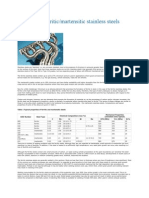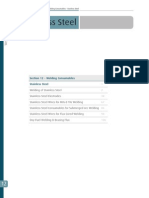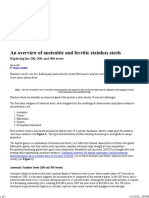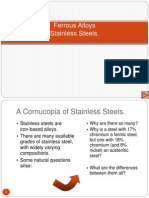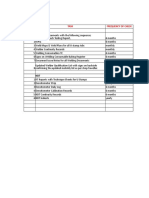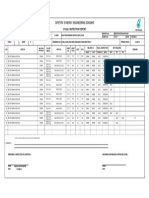Magnetism in ss304
Magnetism in ss304
Uploaded by
g_sanchetiCopyright:
Available Formats
Magnetism in ss304
Magnetism in ss304
Uploaded by
g_sanchetiOriginal Description:
Original Title
Copyright
Available Formats
Share this document
Did you find this document useful?
Is this content inappropriate?
Copyright:
Available Formats
Magnetism in ss304
Magnetism in ss304
Uploaded by
g_sanchetiCopyright:
Available Formats
MAGNETISM IN 304 and 316
304 stainless steel contains chromium (min. 18%), and nickel (min. 8%). It is an austenite
steel and is only slightly responsive to magnetic fields. It also contains 18 – 20%
chromium and 8-10.50% nickel, and lesser quantities of some other elements.
316 stainless steel is a molybdenum-alloyed steel. The fact that it is also negligibly
responsive to magnetic fields means that it can be used in applications where a non-
magnetic metal is required. It also contains a number of other elements in varying
concentrations.
Any process which can change the crystal structure of stainless steel can cause austenite
to be converted to the ferromagnetic martensite or ferrite forms of iron. These processes
include cold working, machining and welding. It is also possible for austenite to
spontaneously convert to martensite at low temperatures. To complicate matters further,
the magnetic properties of these alloys depend on the alloy composition. Within the
allowed ranges of variation of Ni and Cr, significant differences in magnetic properties may
be observed for a given alloy.
Welding consumables for 316L materials are designed to produce a small amount of
ferrite in the deposited weld to avoid weld hot cracking, this is why the weld shows some
magnetism i.e. the deposited weld metal does not contain a 100% austenite phase. It is
normal to check the ferrite level of completed 316L welds to ensure the ferrite % is in the
range 3% to 8% in order to give adequate protection from hot cracking and required
properties at low temperature.
What can be done to minimize the magnetization of stainless steel components?
Ferrite free" welding rods are available to minimize the tendency of welds to become
magnetic. In principle, a welded or machined component can be annealed to restore it to
its nonmagnetic state, although this is not always convenient.
Selecting a 316 stainless steel with nickel content that is in the upper side of the allowed
content range may also be helpful, but again, may not always be practical. The 316N
stainless steel alloy is expected to have less of a tendency to become magnetic than 316
or 316L, however, it may not be readily available.
You might also like
- Mseb Electricity BillDocument1 pageMseb Electricity Billg_sanchetiNo ratings yet
- SS316 Corrosion RateDocument13 pagesSS316 Corrosion Ratenarayana reddy100% (1)
- Stainless Steel Five TypesDocument40 pagesStainless Steel Five Typessids82No ratings yet
- 20 MN V6Document1 page20 MN V6g_sanchetiNo ratings yet
- Acid Cleaning ReportDocument1 pageAcid Cleaning Reportg_sancheti100% (1)
- RT Technique Sheet + Report Rev 4Document2 pagesRT Technique Sheet + Report Rev 4g_sancheti100% (4)
- Level 2 Ut QuestionsDocument82 pagesLevel 2 Ut Questionsg_sancheti80% (5)
- Equivalent ASME en MaterialsDocument3 pagesEquivalent ASME en MaterialstvsshindeNo ratings yet
- Welding Metallurgy - Unit 12 - WEEK 11 PDFDocument3 pagesWelding Metallurgy - Unit 12 - WEEK 11 PDFDilipNo ratings yet
- ANSI B36.19, ASME B36.10 NB Sizes, Weights, Pipe Size ChartDocument2 pagesANSI B36.19, ASME B36.10 NB Sizes, Weights, Pipe Size ChartMetline Industries100% (1)
- Welding Consumables-Stainless SteelDocument32 pagesWelding Consumables-Stainless SteelImran Khan100% (1)
- Welding of Ferritic/martensitic Stainless Steels: Job KnowledgeDocument2 pagesWelding of Ferritic/martensitic Stainless Steels: Job KnowledgeMuhammed SulfeekNo ratings yet
- 127.study The Effect of Welding Parameters of Tig Welding of PlateDocument43 pages127.study The Effect of Welding Parameters of Tig Welding of PlatemoorthikumarNo ratings yet
- Section 12 - Welding Consumables - Stainless Steel266 - 27357Document106 pagesSection 12 - Welding Consumables - Stainless Steel266 - 27357getgateclose100% (1)
- Magnetic Response of Cast Stainless SteelsDocument3 pagesMagnetic Response of Cast Stainless SteelssnorklingmonkeyNo ratings yet
- Stainless Steel FastenersDocument3 pagesStainless Steel FastenersStainless Steel FastenersNo ratings yet
- Section 12 - 5 Stainless Steel WEB - tcm387-508317Document87 pagesSection 12 - 5 Stainless Steel WEB - tcm387-508317VenkateshNo ratings yet
- 300 SS TigDocument10 pages300 SS TigSameer KhanNo ratings yet
- Magnetism in Stainless SteelDocument4 pagesMagnetism in Stainless Steelhyperm2mNo ratings yet
- Magnetism in Stainless SteelDocument4 pagesMagnetism in Stainless Steeltroyel99No ratings yet
- An Overview of Austenitic and Ferritic Stainless Steels - The FabricatorDocument7 pagesAn Overview of Austenitic and Ferritic Stainless Steels - The FabricatorAhmadiBinAhmadNo ratings yet
- Welding of Ferritic _ Martensitic Stainless Steels - TWIDocument6 pagesWelding of Ferritic _ Martensitic Stainless Steels - TWIDaniel DominicesNo ratings yet
- Welding A Cast IronDocument9 pagesWelding A Cast Ironjatin jainNo ratings yet
- Martensitic Stainless SteelsDocument8 pagesMartensitic Stainless SteelsAdilmar E. NatãnyNo ratings yet
- Stainless Steel: Weldability and Joining of MaterialsDocument3 pagesStainless Steel: Weldability and Joining of MaterialsMehmet SoysalNo ratings yet
- Magnesium JoiningDocument4 pagesMagnesium Joiningst_anbu9650No ratings yet
- Magnetic Properties of 304 & 316 Stainless SteelDocument5 pagesMagnetic Properties of 304 & 316 Stainless Steelinspector.gartaganiNo ratings yet
- Link Untuk Menghitung Laju KorosiDocument2 pagesLink Untuk Menghitung Laju KorosiRhulee SinagaNo ratings yet
- The References Are Taken From Nidi (Nickel Development Institute) Twi (The Welding Institute) Lincoln Electric International Molybdenum AssociationDocument21 pagesThe References Are Taken From Nidi (Nickel Development Institute) Twi (The Welding Institute) Lincoln Electric International Molybdenum Associationarif maulanafNo ratings yet
- Principal of DPTDocument5 pagesPrincipal of DPTJhandu KumarNo ratings yet
- Joining Stainless Steel by Soldering, Brazing and Resistance WeldingDocument4 pagesJoining Stainless Steel by Soldering, Brazing and Resistance WeldingA K SinghNo ratings yet
- Stainless Steel SchafflaerDocument15 pagesStainless Steel Schafflaerzidan ojaNo ratings yet
- Magnetic Effects of Stainless SteelDocument2 pagesMagnetic Effects of Stainless SteelIkhsan LyNo ratings yet
- Welding of Stainless SteelsDocument8 pagesWelding of Stainless SteelsFord KatimNo ratings yet
- Ferrous Alloys Stainless SteelsDocument41 pagesFerrous Alloys Stainless SteelsSumedh SinghNo ratings yet
- Reference Inference: Review of Hot Cracking Phenomena in Austenitic Stainless SteelsDocument4 pagesReference Inference: Review of Hot Cracking Phenomena in Austenitic Stainless SteelsHarish KrishnaNo ratings yet
- Tips For Successfully Welding Stainless Steel To Carbon SteelDocument5 pagesTips For Successfully Welding Stainless Steel To Carbon SteelAchu Balachandran100% (1)
- Aisi 316Document4 pagesAisi 316Aliakbar SaifeeNo ratings yet
- 316LNDocument3 pages316LNGanesh KcNo ratings yet
- Gtaw Sepl 2020-21Document24 pagesGtaw Sepl 2020-21Kunal ParikhNo ratings yet
- Incoloy Alloy 25-6MODocument13 pagesIncoloy Alloy 25-6MOsiswoutNo ratings yet
- Technical Bulletin: Magnetism and Other Properties of Stainless SteelDocument2 pagesTechnical Bulletin: Magnetism and Other Properties of Stainless SteelksNo ratings yet
- Weldability of Stainless SteelDocument29 pagesWeldability of Stainless SteelEr Mishal GandhiNo ratings yet
- Tips For Successfully Welding Stainless Steel To Carbon SteelDocument2 pagesTips For Successfully Welding Stainless Steel To Carbon SteeladityaNo ratings yet
- 304L WeldingDocument6 pages304L Weldingeedbdmdud100% (1)
- SS 316 (CF8M) & SS 316L (CF3M)Document1 pageSS 316 (CF8M) & SS 316L (CF3M)Vijayakumar Atthuluri100% (2)
- 316 SensitizationDocument15 pages316 SensitizationRami GhorbelNo ratings yet
- WSRC Ms 2001 00544Document25 pagesWSRC Ms 2001 00544arjun prajapatiNo ratings yet
- Lincoln Stainless Welding GuideDocument40 pagesLincoln Stainless Welding GuideAnonymous yQ7SQr100% (1)
- Acom86 - 1+2 Engineering Properties of Duplex SS (2205, 2307) PDFDocument24 pagesAcom86 - 1+2 Engineering Properties of Duplex SS (2205, 2307) PDFpipedown456No ratings yet
- 316 316l Data SheetDocument2 pages316 316l Data SheetDiman Aditya KardiNo ratings yet
- Allegheny 316 PDFDocument13 pagesAllegheny 316 PDFJoshua WalkerNo ratings yet
- Difference Between 304 and 316 Stainless SteelDocument4 pagesDifference Between 304 and 316 Stainless SteelsekarsanthanamNo ratings yet
- Austenitic Stainless SteelsDocument4 pagesAustenitic Stainless Steelsandy1036100% (2)
- Considerations For The Weldability of Types 304L and 316L Stainless SteelDocument8 pagesConsiderations For The Weldability of Types 304L and 316L Stainless Steelluisgonzalezf95No ratings yet
- Welding of Copper and Its AlloysDocument30 pagesWelding of Copper and Its Alloysaj87_goswami100% (2)
- Magnetic Response of Stainless Steels: What Are The Basic Magnetic Properties of Materials?Document3 pagesMagnetic Response of Stainless Steels: What Are The Basic Magnetic Properties of Materials?hendraox3996No ratings yet
- Welding of Austenitic Stainless Steel - Job Knowledge 103Document2 pagesWelding of Austenitic Stainless Steel - Job Knowledge 103chowhkNo ratings yet
- Types of Stainless SteelDocument5 pagesTypes of Stainless SteelAnonymous 6ZWS6IG2J9No ratings yet
- Welding Stainless Steels ProcessDocument42 pagesWelding Stainless Steels ProcessRuben Luna RiveroNo ratings yet
- Nickel Magnetic Brittle Hardness Carbon Heat Treatment Razor Blade SteelsDocument2 pagesNickel Magnetic Brittle Hardness Carbon Heat Treatment Razor Blade Steelssunil1879No ratings yet
- SS316 - Comparison With SS316LDocument3 pagesSS316 - Comparison With SS316LAdrianus PrimaNo ratings yet
- Oxy-Acetylene Welding and Cutting: Electric, Forge and Thermit Welding together with related methods and materials used in metal working and the oxygen process for removal of carbonFrom EverandOxy-Acetylene Welding and Cutting: Electric, Forge and Thermit Welding together with related methods and materials used in metal working and the oxygen process for removal of carbonRating: 4 out of 5 stars4/5 (1)
- The Study of Elementary Electricity and Magnetism by Experiment: Containing Two Hundred Experiments Performed with Simple, Home-made ApparatusFrom EverandThe Study of Elementary Electricity and Magnetism by Experiment: Containing Two Hundred Experiments Performed with Simple, Home-made ApparatusNo ratings yet
- Coupon Code:HDFCTC500: Additional Rs.500 Off On Rs.2000 and AboveDocument14 pagesCoupon Code:HDFCTC500: Additional Rs.500 Off On Rs.2000 and Aboveg_sanchetiNo ratings yet
- 4.1 Weldwell ElectrodesDocument10 pages4.1 Weldwell Electrodesg_sanchetiNo ratings yet
- Travel Expenses SheetDocument2 pagesTravel Expenses Sheetg_sanchetiNo ratings yet
- Branch Timings - YES Bank April19 PDFDocument112 pagesBranch Timings - YES Bank April19 PDFg_sanchetiNo ratings yet
- Wise MoneyDocument20 pagesWise Moneyg_sanchetiNo ratings yet
- Tolerances 10Document1 pageTolerances 10g_sanchetiNo ratings yet
- Compound Document Structure Manufacturers Record Book Index (Mri) 17052048-QA-MRB-068-V3006-001 SectionsDocument4 pagesCompound Document Structure Manufacturers Record Book Index (Mri) 17052048-QA-MRB-068-V3006-001 Sectionsg_sanchetiNo ratings yet
- Material Comparison ChartDocument2 pagesMaterial Comparison Chartg_sanchetiNo ratings yet
- HIC Testing As Per NACE MR 0275Document3 pagesHIC Testing As Per NACE MR 0275g_sancheti100% (1)
- New Microsoft Office Excel WorksheetDocument2 pagesNew Microsoft Office Excel Worksheetg_sanchetiNo ratings yet
- Caustic PermagnateDocument3 pagesCaustic Permagnateg_sanchetiNo ratings yet
- 01-WM01 704-V-14 2nd Stage Suction Drum - pdf.PdfCompressor-1718268Document18 pages01-WM01 704-V-14 2nd Stage Suction Drum - pdf.PdfCompressor-1718268g_sanchetiNo ratings yet
- Vishal QC EngineerDocument3 pagesVishal QC Engineerg_sanchetiNo ratings yet
- Blum MRPDocument300 pagesBlum MRPMansingh NepramNo ratings yet
- Castings, Steel and Alloy, Common Requirements, For General Industrial UseDocument12 pagesCastings, Steel and Alloy, Common Requirements, For General Industrial UseIvan RamirezNo ratings yet
- Test Report Date ULR:-TC677119000007759P Name of Customer & Add. M/s Real Forge & FittingDocument14 pagesTest Report Date ULR:-TC677119000007759P Name of Customer & Add. M/s Real Forge & FittingAnurag YadavNo ratings yet
- M'LnavionDocument50 pagesM'Lnavionahmed ismailNo ratings yet
- ASTM 재질분류표Document106 pagesASTM 재질분류표오덕환Oh Duckhwan100% (1)
- Good Fabrication in Architectural Stainless Steel: ISBN 2-87997-062-8Document10 pagesGood Fabrication in Architectural Stainless Steel: ISBN 2-87997-062-8pavi32No ratings yet
- T1 - Standard Thermodynamic QuantitiesDocument17 pagesT1 - Standard Thermodynamic QuantitiesNorhaszanNo ratings yet
- Application of Alloys: Presented By: Jellyn R. Base BSEE 301-ADocument14 pagesApplication of Alloys: Presented By: Jellyn R. Base BSEE 301-AJohn Andrei MartinezNo ratings yet
- Carbon Equivalent and Multiplying Factor For Hardenability of SteelDocument6 pagesCarbon Equivalent and Multiplying Factor For Hardenability of SteelrizkyrNo ratings yet
- ANSWER Welding MetallurgyDocument3 pagesANSWER Welding MetallurgyShaikhan Nadzemi100% (1)
- Customs Storage Pt. Multi Sejahtera AbadiDocument1 pageCustoms Storage Pt. Multi Sejahtera AbadiEka PrawiraNo ratings yet
- C9D - 1.0304 - SteelNumber - Chemical Composition, Equivalent, PropertiesDocument2 pagesC9D - 1.0304 - SteelNumber - Chemical Composition, Equivalent, PropertiesSergiNo ratings yet
- Touchstone Method of Gold Testing.Document18 pagesTouchstone Method of Gold Testing.Mohiuddin Al Kadri100% (1)
- Adore Electrode BookletDocument207 pagesAdore Electrode BookletKrisna SinghNo ratings yet
- Tec Metaric Materials Xref En-UsDocument4 pagesTec Metaric Materials Xref En-UsSalvadorNo ratings yet
- Agree Not PaidDocument121 pagesAgree Not PaidIndah DestianiNo ratings yet
- 1.4313 BS 3100 425C11Document1 page1.4313 BS 3100 425C11g1ann1sNo ratings yet
- MaterialDocument2 pagesMaterialdurgeshwardNo ratings yet
- Building Technology 1: Research WorkDocument54 pagesBuilding Technology 1: Research WorkRhobie Shayne BenogsodanNo ratings yet
- Tabel Data PercobaanDocument13 pagesTabel Data PercobaanikeuNo ratings yet
- Dipetro Synergy Engineering SDN BHD: Visual Inspection ReportDocument1 pageDipetro Synergy Engineering SDN BHD: Visual Inspection ReportMohd SaffririzalNo ratings yet
- ChosunDocument201 pagesChosunsanketpavi21No ratings yet
- CF8M VS CF8 Stainless Steel Casting - JC CastingDocument7 pagesCF8M VS CF8 Stainless Steel Casting - JC CastingSHivaprasad APITNo ratings yet
- EHB en File 9.7.3 Equivalent ASME en MaterialsDocument3 pagesEHB en File 9.7.3 Equivalent ASME en MaterialsRamuAlagappanNo ratings yet
- Equivalents of Carbon Steel QualitiesDocument10 pagesEquivalents of Carbon Steel Qualitiesibson045001256No ratings yet
- Alloys: Prepared By: Ahmad Najibullah Bin Che MohdDocument22 pagesAlloys: Prepared By: Ahmad Najibullah Bin Che Mohdganu89No ratings yet
- Is-00228-Part03 - Chemical Analysys of SteelDocument10 pagesIs-00228-Part03 - Chemical Analysys of Steelnishanth132100% (1)











